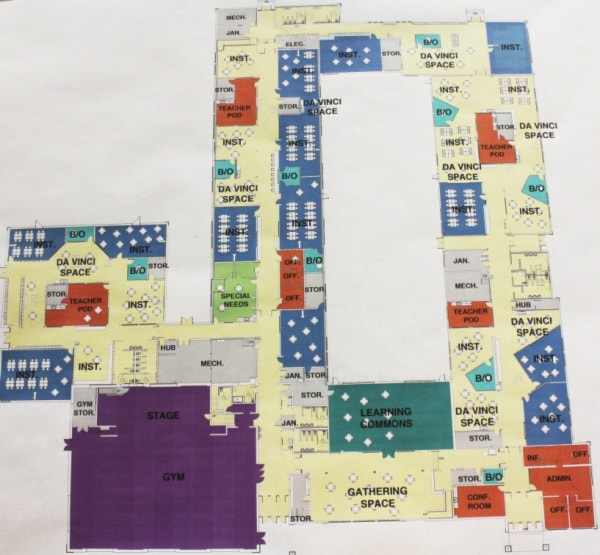As the renovations at the former Diamond Willow Middle School continue, it’s clear that the inside of the soon-to-be new elementary school has been designed to support the changes occurring within the education sector.
Inspiring Education is a new concept based on the set of ideals centered on nurturing well-rounded students who are more focused on the application of what they have learned rather than how many facts they can memorize.
“School traditions have been very similar for the last 50 years. In the future, that’s going to change and it’s going to change in a very short period of time,” said Gerry Varty, assistant superintendent of learning support and system improvement.
What’s now being called traditional schools have been designed with a straight hallways and boxy, isolated classroom formula — “the cells and bells model” — but this design is now being found to impede the outcomes required by Inspiring Education. “What we’re after now is thought process, working together and problem solving skills,” said Varty.
No longer is straight fact memorization the most important part of a child’s education. Varty says in the coming years, the most sought after graduates don’t have to be the smartest students but the ones with the abilities to find the answers they don’t know, as well as display ethical, empathetic, adaptable and teamwork abilities. “The kids we turn out today don’t necessarily have to be the kids we turned out yesterday. We’re turning them out into a different world.”
“We’re going to be less focused on schooling and more focused on learning,” he added. Provincial Achievement Tests are going to be replaced by Student Learning Assessments. They are to be written in the fall rather than spring so teachers can be pre-emptive to identify areas students struggle in rather than learn what was not grasped at the end of the school year.
The cross-curriculum ‘real life skills’ being taught through Inspiring Education, as well as flexible learning schedules, are going to help ensure every student is given equal opportunity in learning. “Inclusion is the idea we’re going to include all of our kids in education. Now that doesn’t mean you never get pulled out, you get pulled out, you get extra help and you go back in.”
Inspiring Education also takes into account educating students in a fully globalized and interconnected world where a youth’s job competition could be living on the other side of earth. “We’re moving away from classrooms so to speak and we’re learning about collaborative communities. Because the world exists as a collaborative venture schools must also exist as collaborative ventures,” said Varty.
The school’s renovations mirror the idea of flexible learning and collaborative ventures through learning communities for each grade rather than separating grades into individual classrooms. However, the ideas of classrooms won’t be eliminated. New designs open up classrooms with more windows and access points.
The school is also creating so called “Da Vinci” areas to encourage collaboration and creativity among students.
The hallways are being widened and reclaimed as learning space for large groups to be taught collaboratively or work together in smaller groups under the supervision of a teacher. “We envision a collaborative culture. So, students learning from students, teachers learning from teachers . . . It’s working co-dependently and not in isolation to achieve these goals,” said Varty.
These reclaimed spaces allowed grades to be broken up, yet remain together in one learning area, allowing those who grasp a subject to work at their own pace while those who struggle can work with a teacher for support, Ponoka Elementary School principal Lois Spate explained.
